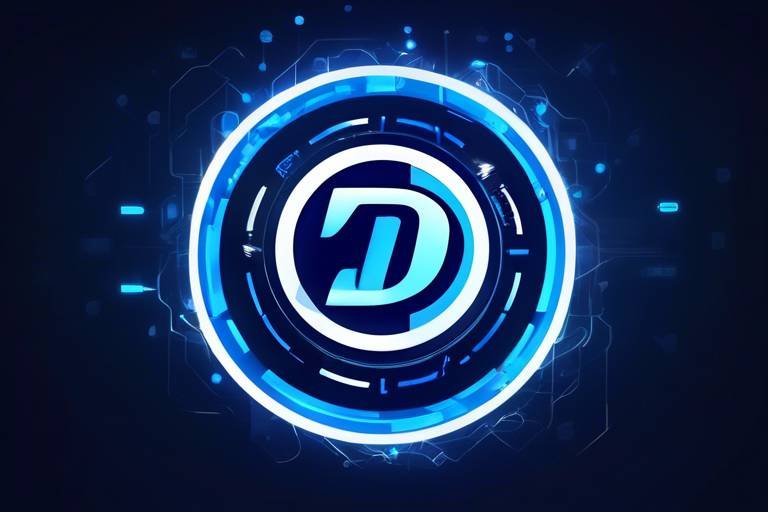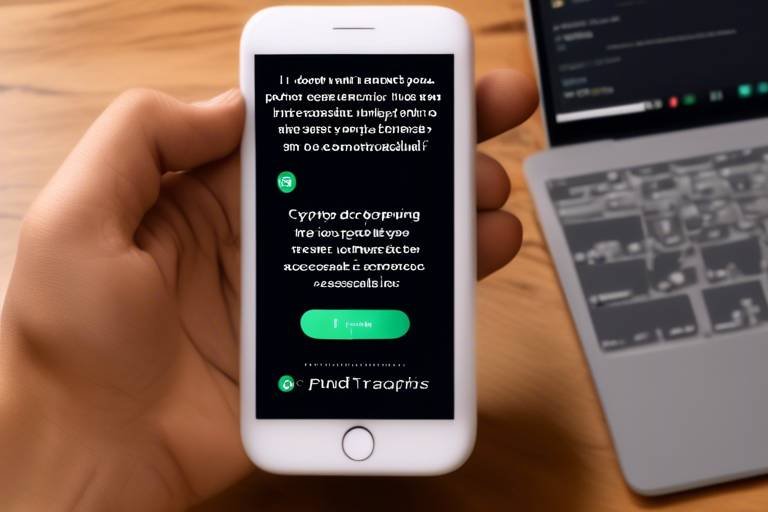Band Protocol - Data Oracles on the Blockchain
In the ever-evolving landscape of blockchain technology, Band Protocol emerges as a pivotal player, acting as a decentralized data oracle platform. But what exactly does that mean? Think of Band Protocol as the essential translator that connects the real world with the digital realm of smart contracts. It pulls in real-time data from various external sources and feeds it into the blockchain, making it possible for smart contracts to execute based on accurate, live information. This not only enhances their functionality but also significantly boosts their reliability.
The importance of data oracles cannot be overstated. Without them, smart contracts would be like a ship lost at sea, unable to navigate without the necessary information to guide their actions. Band Protocol stands out by offering a robust solution that aggregates and connects this real-world data seamlessly to blockchain applications. It’s akin to having a personal assistant who sorts through mountains of information to deliver only what you need, when you need it.
As we dive deeper into the world of Band Protocol, we’ll explore its architecture, the unique features that set it apart from other oracle solutions, and the various use cases that demonstrate its versatility across different industries. From finance to gaming, Band Protocol is not just another tech buzzword; it's a transformative tool that is reshaping how we think about data on the blockchain. So, buckle up as we unravel the intricacies of this fascinating platform!

Understanding Data Oracles
In the world of blockchain technology, the term data oracle might sound like something out of a sci-fi movie, but it's a critical component that helps bridge the gap between the digital and physical realms. So, what exactly is a data oracle? Simply put, it acts as a bridge that allows smart contracts—self-executing contracts with the terms of the agreement directly written into code—to access real-world information. This is important because, without oracles, smart contracts would be limited to the data stored on the blockchain, which is often insufficient for many applications. Imagine trying to make a decision based solely on outdated information; that’s what smart contracts would be doing without oracles!
Data oracles serve a vital role in decentralized systems by providing real-time data that can trigger actions within smart contracts. For example, in a decentralized finance (DeFi) application, a smart contract might need the current price of a cryptocurrency to execute a trade. Without a reliable source of that price, the contract could make decisions based on stale or inaccurate data, leading to financial losses. This is where oracles come into play, fetching and validating data from various external sources before feeding it into the blockchain.
There are different types of data oracles, and they can be categorized based on their data sources:
- Centralized Oracles: These rely on a single data source, which can lead to issues of trust and reliability.
- Decentralized Oracles: These aggregate data from multiple sources, enhancing reliability and reducing the risk of manipulation.
- Inbound Oracles: They provide data from the outside world to the blockchain.
- Outbound Oracles: They send data from the blockchain to the external world.
By utilizing these oracles, smart contracts can execute based on accurate and timely information, making them more functional and reliable. This capability is especially crucial in industries like finance, insurance, and supply chain management, where the accuracy of data can have significant implications. Think of it as a weather app that not only tells you it's sunny outside but also alerts you when a storm is approaching—this real-time data can help you make informed decisions.
Furthermore, the use of data oracles introduces a layer of complexity in terms of security and trust. Since these oracles are the conduits for external data, they must be secure and trustworthy. If an oracle is compromised, it could lead to incorrect data being fed into smart contracts, which could have disastrous consequences. This is why many decentralized protocols, like Band Protocol, employ mechanisms to validate and cross-check data from multiple sources before it reaches the blockchain.
In summary, data oracles are essential for the functionality of smart contracts, allowing them to interact with the real world. They provide the necessary data that enables these contracts to execute accurately and efficiently, ultimately enhancing the reliability of blockchain applications. As we delve deeper into Band Protocol, we'll see how it stands out in the realm of data oracles and contributes to the evolution of decentralized applications.

Overview of Band Protocol
Band Protocol is an innovative decentralized oracle solution that has been designed to seamlessly aggregate and connect real-world data to blockchain applications. Imagine a world where smart contracts can interact with real-time data, making them more functional and reliable. That's exactly what Band Protocol aims to achieve! By acting as a bridge between the blockchain and external data sources, it empowers developers to build applications that require accurate and timely information.
One of the standout features of Band Protocol is its flexibility. Unlike traditional oracles, which often rely on a single data provider, Band Protocol aggregates data from multiple sources. This not only enhances the reliability of the information but also reduces the risk of manipulation or inaccuracies. The architecture of Band Protocol is built to ensure that the data is trustworthy and can be verified by multiple validators, creating a robust ecosystem that developers can rely on.
Let’s break down some of the key aspects that make Band Protocol unique:
- Decentralization: Band Protocol operates on a decentralized network, which means there is no single point of failure. This decentralization enhances security and trust, vital for any blockchain application.
- Cross-Chain Compatibility: Band Protocol is designed to work across various blockchain platforms, allowing for greater interoperability. This means that developers can build applications that leverage data from different blockchains, broadening their scope and functionality.
- Scalability: The protocol is built to scale efficiently, handling large volumes of data without compromising on speed or accuracy. This is crucial as the demand for reliable data continues to grow in the blockchain space.
In essence, Band Protocol is not just another data oracle; it’s a comprehensive solution that addresses the challenges faced by developers in accessing real-world data. By providing a decentralized, scalable, and flexible platform, Band Protocol opens up new possibilities for smart contracts, making them more powerful and applicable in various industries. Whether it’s finance, gaming, or any other sector, the potential applications of Band Protocol are vast and exciting!

Architecture of Band Protocol
This article explores Band Protocol, a decentralized data oracle platform that connects real-world data to smart contracts on the blockchain, enhancing their functionality and reliability.
Data oracles serve as bridges between blockchain networks and external data sources, enabling smart contracts to access real-time information necessary for execution. This section explains their importance and functionality in decentralized systems.
Band Protocol is a decentralized oracle solution designed to aggregate and connect real-world data to blockchain applications. This section discusses its architecture, features, and how it differentiates itself from other oracle solutions.
The architecture of Band Protocol is a sophisticated system that ensures reliable and accurate data delivery to blockchain applications. At its core, Band Protocol employs a decentralized network of validator nodes, which are responsible for verifying the authenticity of data sources. This decentralized approach not only enhances security but also mitigates risks associated with data manipulation.
One of the key components of Band Protocol's architecture is the Data Aggregation Layer. This layer collects data from various sources, such as APIs and other external feeds, and processes it before sending it to the blockchain. By aggregating data, Band Protocol can provide a more comprehensive and accurate representation of real-world events, which is essential for smart contracts to function correctly.
Additionally, Band Protocol utilizes a unique mechanism known as the Oracle Incentive Model. This model incentivizes validators to maintain high standards of data accuracy and reliability. Validators are rewarded with BAND tokens for their efforts in providing quality data, creating a self-sustaining ecosystem that encourages participation and accountability.
To better illustrate the architecture of Band Protocol, here's a simplified diagram:
+---------------------+
| Data Providers |
+---------------------+
|
v
+---------------------+
| Data Aggregation |
| Layer |
+---------------------+
|
v
+---------------------+
| Validator Nodes |
+---------------------+
|
v
+---------------------+
| Blockchain |
+---------------------+
In summary, the architecture of Band Protocol is designed to ensure that data is not only accurate but also delivered in a timely manner. With its combination of validator nodes, data aggregation, and incentivization, Band Protocol stands out as a robust solution in the realm of decentralized data oracles.
In this section, we compare Band Protocol with other popular oracle solutions like Chainlink and API3, highlighting their unique features, advantages, and potential drawbacks in various use cases.
Band Protocol can be applied across various industries, from finance to gaming. This section outlines specific use cases demonstrating how it enhances smart contracts with reliable data.
In the finance sector, Band Protocol is utilized for price feeds and market data, facilitating decentralized finance (DeFi) applications. We explore its impact on the DeFi ecosystem and transaction efficiency.
Gaming and NFTs benefit from Band Protocol by incorporating real-world data into gameplay mechanics and asset valuations. This subsection discusses innovative applications and the potential for enhanced user engagement.
- What is Band Protocol? Band Protocol is a decentralized oracle platform that connects real-world data to blockchain applications, enhancing their functionality.
- How does Band Protocol ensure data accuracy? Through a network of validator nodes that verify data sources and an incentive model that rewards accurate data provision.
- What industries can benefit from Band Protocol? Industries such as finance, gaming, and insurance can leverage Band Protocol for accurate data integration.
- Is Band Protocol similar to Chainlink? While both are oracle solutions, Band Protocol focuses on a decentralized approach with a unique data aggregation process.

Validator Nodes
In the realm of Band Protocol, are the unsung heroes that ensure the integrity and reliability of the data flowing into the blockchain. Think of them as the gatekeepers of information, standing guard to verify that every piece of data is accurate and trustworthy before it gets a ticket to the blockchain party. Without these diligent nodes, smart contracts would be at the mercy of unreliable data, leading to potential chaos in decentralized applications.
So, what exactly do these validator nodes do? Their primary responsibility is to verify data sources. This means they meticulously check the authenticity of the data being fed into the system. They assess whether the data aligns with the expected parameters and standards set by the network. If the data passes the test, it’s then aggregated and sent to the blockchain. If not, it’s rejected, ensuring that only the best and most reliable information makes it through.
Moreover, validator nodes are incentivized to perform their duties effectively. They earn rewards for their work, which not only compensates them for their efforts but also encourages them to act honestly. This creates a system where integrity is not just a moral obligation but a financially rewarding endeavor. The more accurate and reliable the data they provide, the more they stand to gain. This creates a self-sustaining ecosystem where the quality of data is paramount.
To better understand the role of validator nodes, let’s break down their responsibilities:
- Data Verification: Ensuring that the data is accurate and from a credible source.
- Consensus Participation: Engaging in the consensus mechanism to validate transactions and data submissions.
- Reward Distribution: Earning rewards based on the accuracy and reliability of the data they verify.
In summary, validator nodes are crucial for the success of Band Protocol. They not only enhance the reliability of the data but also foster a trustworthy environment for decentralized applications. Without them, the entire structure would be vulnerable to inaccuracies, and the potential of smart contracts would remain unfulfilled. The synergy between these nodes and the blockchain is what truly brings the magic of decentralized finance and applications to life.
- What is the role of validator nodes in Band Protocol? Validator nodes verify and validate data sources, ensuring only accurate information is fed into the blockchain.
- How are validator nodes incentivized? They earn rewards for their contributions, promoting honest and reliable data verification.
- Can validator nodes be compromised? While they play a crucial role in maintaining data integrity, the decentralized nature of the network helps mitigate risks associated with malicious actors.

Data Aggregation Process
The in Band Protocol is a vital cog in the machinery that ensures the integrity and reliability of the data fed into blockchain applications. Imagine a bustling marketplace where vendors gather information from various sources to present the best products to their customers; similarly, Band Protocol meticulously collects, verifies, and aggregates data from diverse real-world sources before it reaches the blockchain. This meticulous approach is what sets Band Protocol apart in the realm of decentralized oracles.
At the heart of this process lies a network of validator nodes, each tasked with the responsibility of scrutinizing data sources. These nodes are like the quality control inspectors in a factory, ensuring that every piece of information is accurate and trustworthy. Once the data is collected, these validators engage in a multi-step verification process:
- Data Collection: Validator nodes gather data from multiple sources, ensuring a wide range of inputs to mitigate the risk of inaccuracies.
- Verification: Each piece of data is cross-checked against other sources to confirm its authenticity. This step is crucial, as it prevents false information from entering the system.
- Aggregation: After verification, the validated data is aggregated into a single, reliable output that can be readily accessed by smart contracts.
This process not only enhances the reliability of the data but also optimizes the efficiency of smart contracts. By utilizing a decentralized approach, Band Protocol minimizes the risk of single points of failure, making it a robust solution for accessing real-time data. Moreover, the use of economic incentives for validators encourages a competitive environment where the best data sources are continually sought after, ensuring that only the most accurate information is utilized.
To illustrate the efficiency of Band Protocol's data aggregation process, consider the following table that outlines the key components involved:
| Component | Function |
|---|---|
| Validator Nodes | Verify and validate data from various sources. |
| Data Sources | Provide real-time information for aggregation. |
| Aggregation Mechanism | Collect and compile verified data into a usable format. |
| Smart Contracts | Utilize aggregated data for execution of transactions. |
In conclusion, the data aggregation process in Band Protocol is not just a backend function; it’s the backbone that supports the entire ecosystem of decentralized applications. By ensuring that only the most accurate and reliable data is fed into smart contracts, Band Protocol significantly enhances the functionality and trustworthiness of blockchain technology.
- What is Band Protocol? Band Protocol is a decentralized data oracle platform that connects real-world data to smart contracts on the blockchain.
- How does the data aggregation process work? The process involves collecting data from various sources, verifying its accuracy through validator nodes, and aggregating it for use in smart contracts.
- Why are validator nodes important? Validator nodes ensure the integrity of the data by verifying and validating the information before it is aggregated and used.
- What are the benefits of using Band Protocol? Band Protocol enhances the reliability of smart contracts by providing accurate real-time data, reducing risks associated with inaccurate information.

Comparison with Other Oracles
When it comes to decentralized applications, the choice of an oracle can significantly impact performance, reliability, and overall user experience. Band Protocol stands out in the crowded oracle landscape, but how does it truly compare to other popular solutions like Chainlink and API3? Each of these platforms has its unique features and advantages, making them suitable for different use cases.
First, let’s take a closer look at Chainlink, arguably the most recognized oracle in the blockchain space. Chainlink operates as a decentralized network of oracles that provides tamper-proof data feeds to smart contracts. Its wide adoption is a testament to its reliability, but it can also be criticized for its higher costs and complexity. In contrast, Band Protocol aims to offer a more streamlined and cost-effective solution by aggregating data from multiple sources before delivering it to the blockchain. This aggregation not only enhances data accuracy but also reduces the risk of relying on a single data provider.
On the other hand, API3 focuses on enabling decentralized APIs, allowing developers to create their own oracles using existing APIs. While this approach offers flexibility, it may lack the robust data validation process that Band Protocol employs. Band’s architecture is designed to ensure that data is verified by validator nodes, which adds an extra layer of trust and security. In a world where data integrity is paramount, this feature can be a game-changer.
To better illustrate the differences, here's a simple comparison:
| Feature | Band Protocol | Chainlink | API3 |
|---|---|---|---|
| Data Aggregation | Yes | No | Yes (via APIs) |
| Validator Nodes | Yes | No | No |
| Cost Efficiency | High | Moderate | Variable |
| Flexibility | Moderate | High | High |
As you can see, each oracle has its strengths and weaknesses, making them suitable for different scenarios. Band Protocol shines when it comes to data accuracy and cost-effectiveness, while Chainlink is often favored for its extensive network and established reputation. API3, with its focus on decentralized APIs, offers flexibility but may sacrifice some aspects of security and reliability.
Ultimately, the best choice depends on the specific needs of your project. If your application requires high data accuracy and cost efficiency, Band Protocol might just be the perfect fit. However, if you prioritize flexibility and a larger network of data sources, Chainlink or API3 may be more suitable. The beauty of the blockchain ecosystem lies in its diversity, allowing developers to select the tools that best meet their unique requirements.
- What is an oracle in blockchain? An oracle is a third-party service that provides real-world data to smart contracts on the blockchain, enabling them to execute based on external information.
- How does Band Protocol ensure data accuracy? Band Protocol uses validator nodes to verify and aggregate data from multiple sources before it is sent to the blockchain, enhancing its reliability.
- Can I use Band Protocol for DeFi applications? Yes, Band Protocol is widely used in the DeFi space for price feeds and market data, making it a valuable tool for decentralized finance applications.
- How does Band Protocol compare to Chainlink? While Chainlink is known for its extensive network, Band Protocol focuses on cost efficiency and data aggregation, providing a different set of advantages.

Use Cases of Band Protocol
Band Protocol is not just a theoretical construct; it has practical implications across various industries, revolutionizing the way data is utilized within smart contracts. Imagine a world where your financial transactions are not only swift but also backed by real-time data, or where your gaming experience is enriched by dynamic, real-world information. This is where Band Protocol shines, providing reliable data feeds that enhance the functionality of decentralized applications (dApps).
One of the most exciting areas where Band Protocol is making waves is in the finance sector. With the rise of decentralized finance (DeFi), the need for accurate price feeds and market data has never been greater. Band Protocol provides these crucial data points, allowing users to execute trades and transactions with confidence. For instance, imagine a DeFi platform that needs to determine the price of Ethereum in real-time to facilitate a trade. Without reliable data, the entire system could falter. Band Protocol steps in here, ensuring that the data is both accurate and timely, thus enhancing the overall transaction efficiency.
Another fascinating application of Band Protocol is found in the realm of gaming and NFTs. As the gaming industry continues to evolve, developers are increasingly looking to integrate real-world data into their games. Band Protocol allows for this integration, enabling gameplay mechanics that react to real-time events. For example, a game could adjust its in-game economy based on current market prices of virtual assets, making the experience more engaging and realistic for players. Moreover, the valuation of NFTs can be dynamically adjusted based on external market conditions, ensuring that players and collectors have a fair understanding of their assets' worth.
Let's take a look at some specific use cases where Band Protocol is making a significant impact:
| Industry | Use Case | Benefits |
|---|---|---|
| Finance | Price Feeds for DeFi | Real-time market data enhances transaction efficiency and accuracy. |
| Gaming | Dynamic Gameplay Mechanics | Increased user engagement through real-world data integration. |
| NFTs | Asset Valuation | Fair market value assessment based on external conditions. |
In summary, Band Protocol is paving the way for innovative applications across multiple sectors, showcasing its versatility and importance in the blockchain ecosystem. Whether it’s enhancing financial transactions or creating immersive gaming experiences, the potential of Band Protocol is vast and continues to grow as more industries recognize the power of accurate, real-time data.
- What is Band Protocol? Band Protocol is a decentralized oracle platform that connects real-world data to smart contracts on the blockchain.
- How does Band Protocol ensure data accuracy? It employs validator nodes to verify data sources, ensuring the integrity of the information provided.
- What industries can benefit from Band Protocol? Band Protocol can be applied in various sectors, including finance, gaming, and NFTs.
- How does Band Protocol compare to other oracle solutions? Band Protocol differentiates itself by focusing on data aggregation and offering unique features that cater to specific use cases.

Finance and DeFi Applications
In the rapidly evolving world of finance, Band Protocol is making waves by providing essential data feeds that empower decentralized finance (DeFi) applications. Imagine trying to make a financial decision without having the latest market data at your fingertips. That's where Band Protocol steps in, acting as a lifeline that connects smart contracts with real-time information. This capability is crucial for DeFi platforms, which rely heavily on accurate price feeds and market data to function effectively.
One of the standout features of Band Protocol is its ability to deliver highly reliable data at a fraction of the cost compared to traditional data providers. Think of it as having a personal financial advisor who not only provides insights but also does so without charging exorbitant fees. This efficiency is particularly important in a sector where every second counts and price fluctuations can lead to significant gains or losses.
For instance, Band Protocol can be utilized in various DeFi applications, including decentralized exchanges (DEXs), lending platforms, and yield farming protocols. By aggregating data from multiple sources, Band ensures that the information fed into these platforms is not only accurate but also tamper-proof. This is akin to having multiple referees in a sports game, ensuring that every call is fair and transparent.
Let’s break down some of the specific ways Band Protocol enhances DeFi:
- Price Feeds: Band provides real-time price feeds for cryptocurrencies and other assets, enabling DEXs to offer fair trading rates.
- Market Data: Access to comprehensive market data allows lending platforms to set accurate interest rates based on supply and demand.
- Risk Assessment: Reliable data helps in evaluating risks associated with various DeFi activities, making it easier for users to make informed decisions.
Moreover, the integration of Band Protocol into DeFi applications fosters a more robust ecosystem. With accurate and timely data, users can engage in activities such as arbitrage trading, where they capitalize on price differences across platforms. This not only enhances user experience but also adds liquidity to the market, promoting a healthier trading environment.
In conclusion, the role of Band Protocol in the finance and DeFi sectors cannot be overstated. By bridging the gap between real-world data and blockchain applications, it not only enhances the functionality of smart contracts but also instills a sense of trust and reliability among users. As the DeFi landscape continues to grow, Band Protocol stands at the forefront, ready to provide the data backbone that will support the next generation of financial innovation.
What is Band Protocol?
Band Protocol is a decentralized data oracle platform that connects real-world data to smart contracts on the blockchain, enhancing their functionality and reliability.
How does Band Protocol improve DeFi applications?
Band Protocol provides accurate and real-time data feeds, which are crucial for price determination, risk assessment, and overall functionality of DeFi applications.
What are the benefits of using Band Protocol over traditional data providers?
Band Protocol offers lower costs, faster data delivery, and enhanced reliability by aggregating data from multiple sources, making it a superior choice for DeFi applications.
Can Band Protocol be used in other industries besides finance?
Yes, Band Protocol can be applied across various industries, including gaming, insurance, and supply chain management, wherever real-time data is essential.

Gaming and NFT Integration
Gaming has evolved tremendously over the years, and with the rise of blockchain technology, we are witnessing a revolution in how games are developed, played, and monetized. One of the most exciting advancements in this space is the integration of Band Protocol with gaming and non-fungible tokens (NFTs). Imagine a world where your in-game achievements and digital assets are not just confined to the game but can be traded, sold, or used across various platforms! This is the power that Band Protocol brings to the gaming industry.
By leveraging Band Protocol, game developers can incorporate real-world data into their games, creating a more immersive and dynamic experience for players. For instance, consider a racing game that utilizes live weather data to affect gameplay. If it starts to rain in the real world, the game could respond by making the track slippery, thus adding a layer of realism that keeps players on their toes. This kind of integration not only enhances gameplay but also increases player engagement, as they feel a deeper connection to the game world.
Moreover, NFTs have taken the gaming industry by storm, allowing players to truly own their in-game assets. With Band Protocol, the valuation of these NFTs can be anchored to real-world data. For example, a rare in-game sword could have its value dynamically adjusted based on current market trends or player demand. This means that players can buy, sell, or trade their NFTs with confidence, knowing that their value is backed by reliable data. The potential for cross-platform ownership of digital assets further expands the possibilities for gamers, as they can take their achievements from one game to another.
To illustrate the impact of Band Protocol on gaming and NFTs, let’s look at a few key benefits:
- Dynamic Gameplay: Real-time data integration allows for more engaging and responsive gaming experiences.
- True Ownership: NFTs provide players with actual ownership of their in-game assets, making them valuable beyond the game itself.
- Market-Driven Valuation: The value of NFTs can be adjusted based on real-world data, ensuring fair pricing and transparency.
As the gaming industry continues to embrace blockchain technology, the role of Band Protocol will only grow in significance. Developers who utilize this decentralized oracle solution will not only enhance their games but also tap into a broader market of players who are eager for innovative experiences. The fusion of gaming and NFTs through Band Protocol is not just a trend; it’s a glimpse into the future of how we will interact with digital worlds. So, whether you're a gamer, a developer, or an investor, keeping an eye on Band Protocol and its applications in gaming is definitely worth your while!
Q1: How does Band Protocol improve gaming experiences?
A1: Band Protocol enhances gaming experiences by integrating real-world data into gameplay, allowing for dynamic changes and more immersive environments.
Q2: What are NFTs, and how are they used in gaming?
A2: NFTs, or non-fungible tokens, are unique digital assets that represent ownership of a specific item or piece of content in a game, allowing players to buy, sell, and trade them.
Q3: Can Band Protocol be used across different games?
A3: Yes, Band Protocol enables cross-platform ownership of digital assets, meaning NFTs can be utilized in multiple games, creating a larger ecosystem for players.
Q4: What benefits do developers gain from using Band Protocol?
A4: Developers benefit from enhanced gameplay, true ownership for players, and market-driven valuation of in-game assets, leading to increased player engagement and satisfaction.
Frequently Asked Questions
- What is Band Protocol?
Band Protocol is a decentralized data oracle platform that connects real-world data to smart contracts on the blockchain. It enhances the functionality and reliability of these contracts by providing them with accurate and timely information from external sources.
- How do data oracles work?
Data oracles act as intermediaries between blockchain networks and external data sources. They enable smart contracts to access real-time information necessary for execution, ensuring that the contracts can react to real-world events and conditions.
- What makes Band Protocol different from other oracle solutions?
Band Protocol differentiates itself through its unique architecture, which emphasizes data accuracy and reliability. It utilizes a decentralized network of validator nodes to verify data sources, ensuring that the information provided to smart contracts is trustworthy.
- What are validator nodes in Band Protocol?
Validator nodes are essential components of Band Protocol. They verify data sources and ensure the integrity of the information being aggregated. These nodes are incentivized to maintain high standards of accuracy and reliability in the data they provide.
- How does Band Protocol aggregate data?
The data aggregation process in Band Protocol involves collecting information from various sources and validating it before it reaches the blockchain. This ensures that the data used in smart contracts is both accurate and reliable.
- Can you give examples of use cases for Band Protocol?
Band Protocol can be applied in various industries, including finance and gaming. In finance, it is used for price feeds and market data in decentralized finance (DeFi) applications. In gaming, it helps integrate real-world data into gameplay mechanics and asset valuations.
- How does Band Protocol enhance DeFi applications?
In the DeFi ecosystem, Band Protocol provides reliable price feeds and market data, enabling more efficient and secure transactions. This helps users make informed decisions and enhances the overall functionality of DeFi platforms.
- What benefits does Band Protocol offer for gaming and NFTs?
Band Protocol enhances gaming and NFTs by incorporating real-world data into gameplay mechanics and asset valuations. This innovation leads to improved user engagement and creates more dynamic and interactive gaming experiences.



















